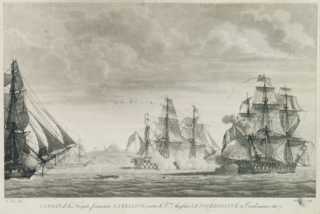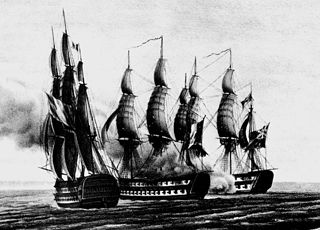
Louis-Thomas Villaret de Joyeuse was a French admiral.

In the Battle of Cape Finisterre off Galicia, Spain, the British fleet under Admiral Robert Calder fought an indecisive naval battle against the combined Franco-Spanish fleet which was returning from the West Indies. Failing to prevent the joining of French Admiral Pierre de Villeneuve's fleet to the squadron of Ferrol and to strike the shattering blow that would have freed Great Britain from the danger of an invasion, Calder was later court-martialled and severely reprimanded for his failure and for avoiding the renewal of the engagement on 23 and 24 July. At the same time, in the aftermath Villeneuve elected not to continue on to Brest, where his fleet could have joined with other French ships to clear the English Channel for an invasion of Great Britain.

Vice-Admiral Count Pierre Étienne René Marie Dumanoir Le Pelley was a French Navy officer, best known for commanding the vanguard of the French fleet at the Battle of Trafalgar. His conduct during this battle was the subject of controversy.

Héros was a 74-gun ship of the line of the French Navy, known mostly for being the flagship of Pierre André de Suffren de Saint Tropez during the Anglo-French War.

Count Honoré Joseph Antoine Ganteaume was a French Navy officer and Vice-admiral.

Jean-Baptiste Philibert Willaumez was a French naval officer and nobleman who served during the French Revolutionary Wars and Napoleonic Wars. Willaumez joined the French Navy at the age of 14, and proved to be a competent sailor. Having risen to the rank of pilot, he started studying navigation, attracting the attention of his superiors up to Louis XVI himself. Willaumez eventually became an officer and served under Antoine Bruni d'Entrecasteaux in his expedition to rescue Jean-François de Galaup, comte de Lapérouse and explore the Indian Ocean and Oceania.

Bellone was an Iphigénie-class 32-gun frigate of the French Navy on plans by Léon-Michel Guignace. She took part in the American Revolutionary War in the Indian Ocean with the squadron under Suffren, and later in the French Revolutionary Wars. She was present at the Glorious First of June.

Pierre-François-Henri-Étienne Bouvet de Maisonneuve was a French Navy officer and privateer.

John Maitland was an officer of the Royal Navy, who saw service during the French Revolutionary and Napoleonic Wars, eventually rising to the rank of Rear-Admiral.

Sir Edward Buller, 1st Baronet was an officer of the Royal Navy who served during the American War of Independence and the French Revolutionary and Napoleonic Wars.

Admiral comte Pierre André de Suffren de Saint Tropez, bailli de Suffren, Château de Saint-Cannat) was a French Navy officer and admiral. Beginning his career during the War of the Austrian Succession, he fought in the Seven Years' War, where he was taken prisoner at the Battle of Lagos. Promoted to captain in 1772, he was one of the aids of Admiral d'Estaing during the Naval battles of the American Revolutionary War, notably taking part in the Siege of Savannah.

Diligente was a 20-gun corvette of the French Navy, lead ship of her class. Built at Brest on private plans by Pierre Ozanne, she was particularly fast. The French Navy adopted the design and copied the plans as late as 1848. Originally armed with 6-pounder guns, she was later rearmed with heavier carronades. She continued in service, off and on, until she was struck in 1854.

The Mediterranean campaign of 1798 was a series of major naval operations surrounding a French expeditionary force sent to Egypt under Napoleon Bonaparte during the French Revolutionary Wars. The French Republic sought to capture Egypt as the first stage in an effort to threaten British India and support Tipu Sultan, and thus force Great Britain to make peace. Departing Toulon in May 1798 with over 40,000 troops and hundreds of ships, Bonaparte's fleet sailed southeastwards across the Mediterranean Sea. They were followed by a small British squadron under Rear-Admiral Sir Horatio Nelson, later reinforced to 13 ships of the line, whose pursuit was hampered by a lack of scouting frigates and reliable information. Bonaparte's first target was the island of Malta, which was under the government of the Knights of St. John and theoretically granted its owner control of the Central Mediterranean. Bonaparte's forces landed on the island and rapidly overwhelmed the defenders, securing the port city of Valletta before continuing to Egypt. When Nelson learned of the French capture of the island, he guessed the French target to be Egypt and sailed for Alexandria, but passed the French during the night of 22 June without discovering them and arrived off Egypt first.

Jean-Pierre Étienne was a French Navy officer.

Ganteaume's expeditions of 1801 were three connected major French Navy operations of the spring of 1801 during the French Revolutionary Wars. A French naval squadron from Brest under Contre-amiral Honoré Ganteaume, seeking to reinforce the besieged French garrison in Ottoman Egypt, made three separate but futile efforts to reach the Eastern Mediterranean. The French army in Egypt had been trapped there shortly after the start of the Napoleonic campaign in Egypt in 1798, when the French Mediterranean Fleet was destroyed at the Battle of the Nile. Since that defeat, the French Navy had maintained only a minimal presence in the Mediterranean Sea, while the more numerous British and their allies had succeeded in blockading and defeating several French bases almost unopposed.

The action of 24 June 1801 was a minor naval engagement during the French Revolutionary Wars. A British ship of the line, HMS Swiftsure under Captain Benjamin Hallowell was passing westwards through the Southern Mediterranean near Cape Derna when it encountered a much larger French squadron under Contre-Amiral Honoré Ganteaume that was also returning westwards after a failed attempt to reinforce the besieged French garrison in Egypt. Although Hallowell immediately recognised the danger his vessel was in and turned to flee, the French ships were much faster and soon closed with his ship. At 14:00, three French vessels were within long gunshot and Hallowell decided that his only hope of escape lay in disabling the three ships before the rest of the French squadron could join the engagement. Turning towards the enemy, Hallowell found that his sluggish ship was unable to respond rapidly to French manoeuvres and within two hours Swiftsure was surrounded. Threatened with complete destruction and unable to escape, the British captain surrendered.

The Algeciras campaign was an attempt by a French naval squadron from Toulon under Contre-Admiral Charles Linois to join a French and Spanish fleet at Cadiz during June and July 1801 during the French Revolutionary Wars prior to a planned operation against either Egypt or Portugal. To reach Cadiz, the French squadron had to pass the British naval base at Gibraltar, which housed the squadron tasked with blockading Cadiz. The British squadron was commanded by Rear-Admiral Sir James Saumarez. After a successful voyage between Toulon and Gibraltar, in which a number of British vessels were captured, the squadron anchored at Algeciras, a fortified port city within sight of Gibraltar across Gibraltar Bay. On 6 July 1801, Saumarez attacked the anchored squadron, in the First Battle of Algeciras. Although severe damage was inflicted on all three French ships of the line, none could be successfully captured and the British were forced to withdraw without HMS Hannibal, which had grounded and was subsequently seized by the French.
The Croisière de Bruix was the principal naval campaign of the year 1799 during the French Revolutionary Wars. The expedition began in April 1799 when the bulk of the French Atlantic Fleet under Vice-Admiral Étienne Eustache Bruix departed the base at Brest, evading the British Channel Fleet which was blockading the port and tricking the commander Admiral Lord Bridport into believing their true destination was Ireland. Passing southwards, the French fleet narrowly missed joining with an allied Spanish Navy squadron at Ferrol and was prevented by an easterly gale from uniting with the main Spanish fleet at Cádiz before entering the Mediterranean Sea. The Mediterranean was under British control following the destruction of the French Mediterranean Fleet at the Battle of the Nile in August 1798, and a British fleet nominally under Admiral Earl St Vincent was stationed there. Due however to St. Vincent's ill-health, operational control rested with Vice-Admiral Lord Keith. As Keith sought to chase down the French, the Spanish fleet followed Bruix into the Mediterranean before being badly damaged in a gale and sheltering in Cartagena.
Amand Leduc was a French sailor and Navy officer of the First French Empire.

The East Indies theatre of the French Revolutionary Wars was a series of campaigns related to the major European conflict known as the French Revolutionary Wars, fought between 1793 and 1801 between the new French Republic and its allies and a shifting alliance of rival powers. Although the Indian Ocean was separated by vast distance from the principal theatre of the conflict in Western Europe, it played a significant role due to the economic importance of the region to Great Britain, France's most constant opponent, of its colonies in India and the Far Eastern trade.
















